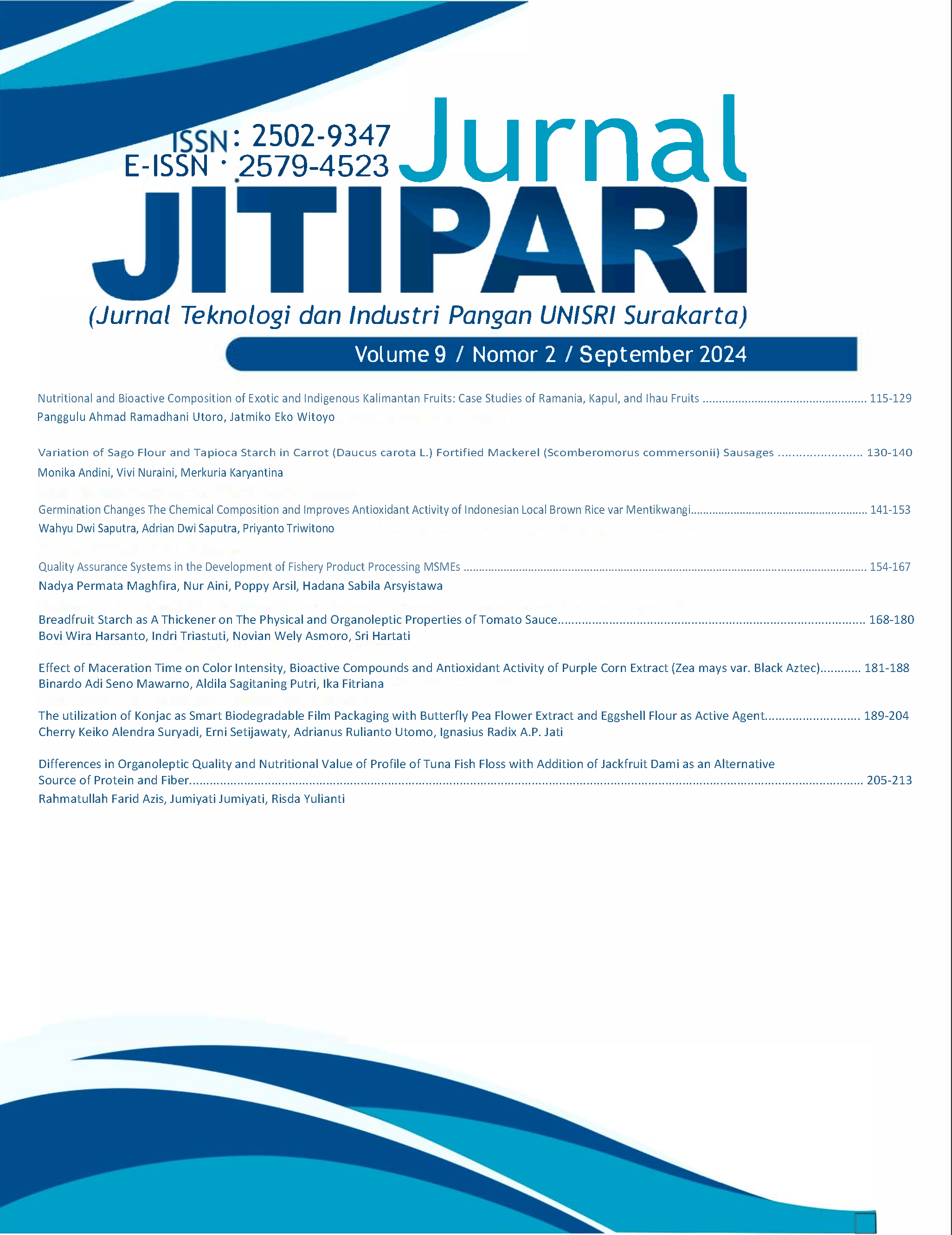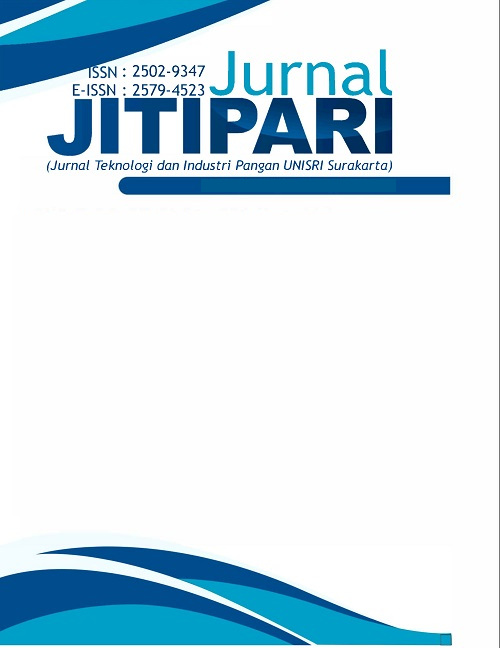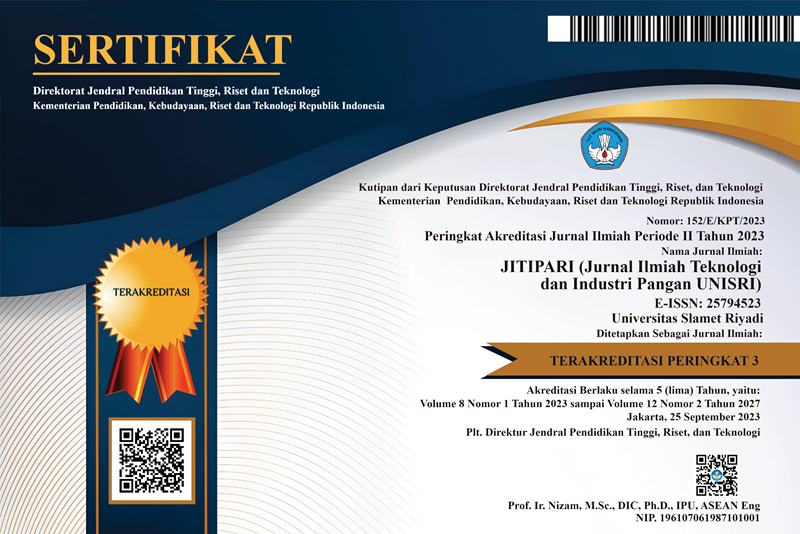Nutritional and Bioactive Composition of Exotic and Indigenous Kalimantan Fruits: Case Studies of Ramania, Kapul, and Ihau Fruits
DOI:
https://doi.org/10.33061/jitipari.v9i2.10314Abstract
Indonesia is renowned for its rich tropical flora diversity, and Kalimantan Island stands out for its exceptional fruit variety. Three fruits, ramania, kapul, and ihau fruits, have drawn particular interest due to their potential health benefits and possible uses in the food and pharmaceutical industries. Nevertheless, these fruits are rarely explored comprehensively. So, this study offers a better understanding of the diverse fruits found in Kalimantan through a comparative analysis of literature data. This literature review aims to provide valuable insights into the nutritional and bioactive properties of these fruits and highlights their potential health benefits. The results from various previous studies exhibited that the exotic and indigenous fruits from Kalimantan, including ramania, kapul, and ihau fruits, are packed with essential nutrients like proteins, fats, carbohydrates, vitamins, and bioactive compounds that act as anti-aging, anti-bacterial, anticancer, antioxidants, and other bioactivities. Moreover, Kalimantan's exotic and indigenous fruits also have great potential as ingredients for functional food or pharmaceutical production. However, further research is necessary to fully explore their potential and innovative applications in various industries.
References
Akhmadi, N. R., & Sumarmiyati. (2015). Eksplorasi dan karakterisasi buah kapul (Baccaurea macrocarpa) di Kabupaten Kutai Barat, Kalimantan Timur. Prosiding Seminar Nasional Masyarakat Biodiversitas Indonesia, 1(4), 923–929. https://doi.org/10.13057/psnmbi/m010448
Antarlina, S. S. (2016). Identifikasi sifat fisik dan kimia buah-buahan lokal Kalimantan. Buletin Plasma Nutfah, 15(2), 80-90. https://doi.org/10.21082/blpn.v15n2.2009.p80-90
Bakar, M. F. A., Ahmad, N. E., Karim, F. A., & Saib, S. (2014). Phytochemicals and antioxidative properties of borneo indigenous liposu (Baccaurea lanceolata) and tampoi (Baccaurea macrocarpa) fruits. Antioxidants, 3(3), 516–525. https://doi.org/10.3390/antiox3030516
Bist, N. S., & Bist, P. (2021). Role of microorganisms in post-harvest loss of agricultural products: A review. Sustainability in Food and Agriculture (SFNA), 2(1), 1-4. https://doi.org/10.26480/sfna.01.2021.01.04
Bölek, S. (2022). Valorization of roasted longan stone in production of functional biscuits with high antioxidant activity and dietary fiber. Food Science and Technology, 42, e69820. https://doi.org/10.1590/fst.69820
Chel-Guerrero, L. D., Cuevas-Glory, L. F., Sauri-Duch, E., Sierra-Palacios, E., De León-Sánchez, F. D., & Mendoza-Espinoza, J. A. (2022). Tropical fruit peels as sources of bioactive compounds: a review. Pakistan Journal of Botany, 54(3), 1169–1179. https://doi.org/10.30848/PJB2022-3(7)
Dechsupa, N., Kantapan, J., Tungjai, M., & Intorasoot, S. (2019). Maprang “Bouea macrophylla Griffith†seeds: proximate composition, HPLC fingerprint, and antioxidation, anticancer and antimicrobial properties of ethanolic seed extracts. Heliyon, 5, e02052. https://doi.org/10.1016/j.heliyon.2019.e02052
Dias, M. C., Pinto, D. C., & Silva, A. M. (2021). Plant flavonoids: Chemical characteristics and biological activity. Molecules, 26(17), 5377. https://doi.org/10.3390/molecules26175377.
Effendi, A. N., Iswahyudi, M., Cho, E., Kumala, S., & Sinaga, E. (2022). Supplementation of Bouea macrophylla fruit juice prevent oxidative stress in rats fed with high-fat high-cholesterol diet through attenuation of lipid peroxidation. International Journal of Biological, Physical and Chemical Studies, 4(2), 20-29.
Erwin, E., Pusparohmana, W. R., Sari, I. P., Hairani, R., & Usman, U. (2018). GC-MS profiling and DPPH radical scavenging activity of the bark of Tampoi (Baccaurea macrocarpa). F1000Research, 7, 1–19. https://doi.org/10.12688/F1000RESEARCH.16643.2
Fărcaș, A. C., Socaci, S. A., Nemeș, S. A., Pop, O. L., Coldea, T. E., Fogarasi, M., & Biriș-Dorhoi, E. S. (2022). An update regarding the bioactive compound of cereal by-products: health benefits and potential applications. Nutrients, 14(17), 3470. https://doi.org/10.3390/nu14173470
Golmohammadi, M., Zamanian, M. Y., Jalal, S. M., Noraldeen, S. A. M., RamÃrezâ€Coronel, A. A., Oudaha, K. H.,Obaid, R.F., Almulla, A.F., Bazmandegan, G., & Kamiab, Z. (2023). A comprehensive review on Ellagic acid in breast cancer treatment: From cellular effects to molecular mechanisms of action. Food Science & Nutrition, 11(12), 7458-7468. https://doi.org/10.1002/fsn3.3699
Górniak, I., Bartoszewski, R., & Króliczewski, J. (2019). Comprehensive review of antimicrobial activities of plant flavonoids. Phytochemistry reviews, 18, 241-272. https://doi.org/10.1007/s11101-018-9591-z
Gunawan, Rizki, M. I., Anafarida, O., & Mahmudah, N. (2021). Modeling potential distribution of baccaurea macrocarpa in South Kalimantan, Indonesia. Biodiversitas, 22(8), 3230–3236. https://doi.org/10.13057/biodiv/d220816
Hanizar, E., & Sari, D. N. R. (2018). Aktivitas antibakteri Pleurotus ostreatus varietas grey oyster pada Staphylococcus aureus dan Pseudomonas aeruginosa. Pustaka Kesehatan, 6(3), 387-392. https://doi.org/10.19184/pk.v6i3.9776.
Hanum, Y. (2016). Dampak Bahaya Makanan Gorengan Bagi Jantung. Jurnal Keluarga Sehat Sejahtera, 14(28), 103–114. https://doi.org/10.24114/jkss.v14i28.4700
Harlan, T. S., Gow, R. V., Kornstädt, A., Alderson, P. W., & Lustig, R. H. (2023). The Metabolic matrix: re-engineering ultraprocessed foods to feed the gut, protect the liver, and support the brain. Frontiers in Nutrition, 10, 1098453. https://doi.org/10.3389/fnut.2023.1098453
Haryono, I. A., Noval, N., & Nugraha, B. (2021). Formulasi buah tampoi (Baccaurea macrocarpa) dalam sediaan masker gel sebagai antiaging. Jurnal Surya Medika, 6(2), 102–110. https://doi.org/10.33084/jsm.v6i2.2126
Ibrahim, Rosamah, E., Hendra, M., Sudiono, E., Rifqi, M. A., & Kusuma, I. W. (2023). Antimicrobial, antioxidant and phytochemical activities of three orangutan plant foods in Wehea-Kelay Landscape, East Kalimantan. IOP Conference Series: Earth and Environmental Science, 1282, 012042. https://doi.org/10.1088/1755-1315/1282/1/012042
Ismuhajaroh, B. N. (2012). Deskripsi buah dan biji mata kucing (Euphoria longana). Agroscientiae, 19(1), 37–39.
Jia, Z., Ji-yun, N., Jing, L., Hui, Z., Ye, L., Farooq, S., Bacha, S. A. S., & Jie, W. (2020). Evaluation of sugar and organic acid composition and their levels in highbush blueberries from two regions of China. Journal of Integrative Agriculture, 19(9), 2352–2361. https://doi.org/10.1016/S2095-3119(20)63236-1
Khalil, N., Elbeltagy, A. E., Aljutaily, T., Ali, A., & Gadallah, M. (2023). Organoleptic, antioxidant activity and microbial aspects of functional biscuit formulated with date fruit fibers grown in Qassim Region. Food Science and Technology, 43, e95222. https://doi.org/10.1590/fst.95222
Khan, M. I., Karima, G., Khan, M. Z., Shin, J. H., & Kim, J. D. (2022). Therapeutic effects of saponins for the prevention and treatment of cancer by ameliorating inflammation and angiogenesis and inducing antioxidant and apoptotic effects in human cells. International Journal of Molecular Sciences, 23(18), 10665. https://doi.org/10.3390/ijms231810665.
Khoo, H. E., Azlan, A., Kong, K. W., & Ismail, A. (2016). Phytochemicals and medicinal properties of indigenous tropical fruits with potential for commercial development. Evidence-Based Complementary and Alternative Medicine, 2016, 7591951. https://doi.org/10.1155/2016/7591951
Khoo, H. E., & Ismail, A. (2009). Stability of carotenoids from hexane fractions of 12 Malaysian underutilised tropical fruits during low temperature storage. Food, 3(1), 43–46.
Kopustinskiene, D. M., Jakstas, V., Savickas, A., & Bernatoniene, J. (2020). Flavonoids as anticancer agents. Nutrients, 12(2), 457. https://doi.org/10.3390/nu12020457
Lolaen, L. A. C., Fatimawali, & Citraningtyas, G. (2013). Uji aktivitas antioksidan kandungan fitokimia jus buah gandaria (Bouea macrophylla Griffith). PHARMACON Jurnal Ilmiah Farmasi-UNSRAT, 2(2), 1–7.
Lawalata, V. N. (2021). The physicochemical characteristics of gandaria (Bouea macrophylla) leather with sugar concentration treatment. IOP Conference Series: Earth and Environmental Science, 883, 012086. https://doi.org/10.1088/1755-1315/883/1/012086
Li, J., Zhang, C., Liu, H., Liu, J., & Jiao, Z. (2020). Profiles of sugar and organic acid of fruit juices: a comparative study and implication for authentication. Journal of Food Quality, 2020, 7236534. https://doi.org/10.1155/2020/7236534
Lim, T. K. (2013). Edible medicinal and non-medicinal plants Volume 6, Fruits. Springer.
Makki, K., Deehan, E. C., Walter, J., & Bäckhed, F. (2018). The impact of dietary fiber on gut microbiota in host health and disease. Cell Host and Microbe, 23(6), 705–715. https://doi.org/10.1016/j.chom.2018.05.012
Maneechai, P., Leelapornpisid, P., & Poomanee, W. (2023). Multifunctional biological activities and cytotoxic evaluation of Bouea macrophylla for cosmetic applications. Natural and Life Sciences Communications, 22(2), e2023030. https://doi.org/10.12982/NLSC.2023.030
Maryuni, D. R., Prameswari, D. A., Astari, S. D., Sari, S. P., & Putri, D. N. (2022). Identification of active compounds in red onion (Allium ascalonicum L.) peel extract by LC-ESI-QTOF-MS/MS and determination of its antioxidant activity. J Teknol Has Pertan, 15(1), 20-33. https://doi.org/10.20961/jthp.v15i1.55451
Masriani, & Fadly, D. (2022). Nutritional profiles of Baccaurea macrocarpa fruit. Food Research, 6(2), 202–208. https://doi.org/10.26656/fr.2017.6(2).273
Minarni, M. (2023). The inhibitory power of pineapple hump ethanol extract toward the growth of Streptococcus mutans. JDHT Journal of Dental Hygiene and Therapy, 4(2), 154-159. https://doi.org/ 10.36082/jdht.v4i2.1268
Moore, A., & Khanna, D. (2023). The role of vitamin C in human immunity and its treatment potential against COVID-19: a review article. Cureus, 15(1), e33740. https://doi.org/10.7759/cureus.33740
Mrowicka, M., Mrowicki, J., Dragan, G., & Majsterek, I. (2023). The importance of thiamine (vitamin B1) in humans. Bioscience Reports, 43, BSR20230374. https://doi.org/10.1042/BSR20230374
Noor, M., Saleh, M., & Subagio, H. (2015). Potensi keanekaragaman tanaman buah-buahan di lahan rawa dan pemanfaatannya. Prosiding Seminar Nasional Masyarakat Biodiversitas Indonesia, 1(6), 1348–1358. https://doi.org/10.13057/psnmbi/m010615
Norhayati, N., Ujrumiah, S., Noviany, A., & Carabelly, A. N. (2019). Antibacterial potential of kapul fruit skin (Baccaurea macrocarpa) on Streptococcus sanguis. ODONTO : Dental Journal, 6(2), 118-124. https://doi.org/10.30659/odj.6.2.118-124
Rahmawati, I. S., Dyanti, G. P., Widyanto, R. M., Maulidiana, A. R., Nabila, W., & Purwestri, R. C. (2023). In vitro evaluation of cytotoxicity effect of ihau fruit extract (Dimocarpus longan var. Malesianus Leenh.) on MCF-7 breast cancer cell line. Indonesian Journal of Human Nutrition, 10(1), 59–67.
Rahmawati, I. S., Widyanto, R. M., Maulidiana, A. R., Madani, M. S., & Riski, C. N. (2022). Aktivitas antioksidan dan antibakteri ekstrak etanol buah ihau (Dimocarpus longan var. malesianus Leenh) terhadap bakteri gram positif (Staphylococcus aureus). Jurnal Al-Azhar Indonesia Seri Sains dan Teknologi, 7(2), 137–146. https://doi.org/10.36722/sst.v7i2.1191
Rajan, N. S., & Bhat, R. (2017). Volatile constituents of unripe and ripe kundang fruits (Bouea macrophylla Griffith). International Journal of Food Properties, 20(8), 1751–1760. https://doi.org/10.1080/10942912.2016.1218892
Rajan, N. S., Bhat, R., & Karim, A. (2014). Preliminary studies on the evaluation of nutritional composition of unripe and ripe ‘Kundang’ fruits (Bouea macrophylla Griffith). International Food Research Journal, 21(3), 985–990.
Rangkadilok, N., Sitthimonchai, S., Worasuttayangkurn, L., Mahidol, C., Ruchirawat, M., & Satayavivad, J. (2007). Evaluation of free radical scavenging and antityrosinase activities of standardized longan fruit extract. Food and Chemical Toxicology, 45(2), 328–336. https://doi.org/10.1016/j.fct.2006.08.022
Rangkadilok, N., Worasuttayangkurn, L., Bennett, R. N., & Satayavivad, J. (2005). Identification and quantification of polyphenolic compounds in longan (Euphoria longana Lam.) fruit. Journal of Agricultural and Food Chemistry, 53, 1387–1392. https://doi.org/10.1021/jf0403484
Rosawanti, P., Hidayati, N., & Hanafi, N. (2021). Potensi sumber pangan lokal di kawasan KHDTK Mungku Baru. Jurnal Hutan Tropis, 9(3), 316–324. https://doi.org/10.20527/jht.v9i3.12332
Salusu, H. D., Ariyani, F., Nurmarini, E., & Zarta, A. R. (2020). Kandungan vitamin C pada tiga jenis buah-buahan genus Baccaurea. Buletin Loupe, 16(02), 12–16.
Saryamassuka, D., Wulandari, R. S., & Suryantini, R. (2022). Identifikasi jenis pohon buah-buahan pada Hutan Tembawang Desa Melapi Kecamatan Putussibau Selatan, Kabupaten Kapuas Hulu. Jurnal Hutan Lestari, 10(1), 68–79.
Senhaji, S., Lamchouri, F., Akabli, T., & Toufik, H. (2022). In vitro antioxidant activities of five β-carboline alkaloids, molecular docking, and dynamic simulations. Structural Chemistry, 33(3), 883-895. https://doi.org/10.1007/s11224-022-01886-3
Shahrajabian, M. H., Sun, W., & Cheng, Q. (2019). Modern pharmacological actions of longan fruits and their usages in traditional herbal remedies. Journal of Medicinal Plants Studies, 7(4), 179–185.
Sofiyanti, N., Fitmawati, Isda, M. N., Agesti, A. R. A., Sari, M., & Pranata, S. (2022). Baccaurea Lour. (Phyllanthaceae Martinov-Malpighiales), underutilized plant from Riau, Indonesia and its phytochemical study. Biodiversitas, 23(2), 937–946. https://doi.org/10.13057/biodiv/d230236
Soulissa, A. G., Lombardo, B., & Widyarman, A. S. (2021). Antibacterial and antibiofilm efficacy of pineapple hump (Ananas comosus) on Porphyromonas gingivalis in vitro. Journal of Dentistry Indonesia, 28(3), 153-157.
Subramanian, A. P., John, A. A., Vellayappan, M. V., Balaji, A., Jaganathan, S. K., Supriyanto, E., & Yusof, M. (2015). Gallic acid: prospects and molecular mechanisms of its anticancer activity. RSC Advances, 5(45), 35608-35621. https://doi.org/10.1039/c5ra02727f
Susi. (2014). Potensi pemanfaatan nilai gizi buah eksotik khas Kalimantan Selatan. Ziraa’ah Majalah Ilmiah Pertanian, 39(3), 144–150.
Sutrisno, A. D., Hasnelly, & Habibaturrohmah. (2019). Identifikasi kandungan (antioksidan, vitamin C dan serat kasar) pada buah lokal dan impor (jeruk, apel dan mangga). Pasundan Food Technology Journal, 6(1), 1–7. https://doi.org/10.23969/pftj.v6i1.1502
Timilsena, Y. P., Phosanam, A., & Stockmann, R. (2023). Perspectives on saponins: food functionality and applications. International Journal of Molecular Sciences, 24(17), 13538. https://doi.org/10.3390/ijms24171358
Tirtana, E., Idiawati, N., Warsidah, & Jayuska, A. (2013). Analisa proksimat, uji fitokimia dan aktivitas (Baccaurea macrocarpa). Kimia Khatulistiwa, 2(1), 42–45.
Uji, T. (2007). Diversity, distribution and potential fruit in Indonesia and its potential. Biodiversitas, 8, 157–167.
Utoro, P. A. R., Witoyo, J. E., Alvianto, D., & Permatasari, N. D. (2022). Extraction methods and bioactivity of essential oils from kesum leaves (Persicaria odorata): a short review. Spizaetus : Jurnal Biologi Dan Pendidikan Biologi, 3(3), 112–126. https://doi.org/10.55241/spibio.v3i3.82
Wijayanti, N. (2017). Fisiologi Manusia & Metabolisme Zat Gizi. UB Press.
Witoyo, J. E., & Utoro, P. A. R. (2023). Phytochemicals - bioactivity of Avicennia marina leaves extract, and its application in food products: a brief literature review. Rona Teknik Pertanian, 16(2), 114–127.
Yang, E. Y., Han, Y. S., & Sim, K. H. (2021). Characterisation of nutritional, physiochemical, and mineral compositions of aril and seed of longan fruit (Dimocarpus longan L.). International Food Research Journal, 28(1), 91–101. https://doi.org/10.47836/ifrj.28.1.09
Zeb, A. (2020). Concept, mechanism, and applications of phenolic antioxidants in foods. Journal of Food Biochemistry, 44(9), e13394. https://doi.org/10.1111/jfbc.13394
Zhu, X-R, Wang, H., Sun, J., Yang, B., Duan, X-W., & Jiang, Y-M. (2019). Pericarp and seed of litchi and longan fruits: constituent, extraction, bioactive activity, and potential utilization. Journal of Zhejiang University: Science B (Biomedicine & Biotechnology), 20(6), 503–512. https://doi.org/10.1631/jzus.B1900161
Downloads
Published
How to Cite
Issue
Section
License
Copyright (c) 2024 Panggulu Ahmad Ramadhani Utoro, Jatmiko Eko Witoyo

This work is licensed under a Creative Commons Attribution-ShareAlike 4.0 International License.
Authors who publish this journal agree to the following terms:
- Authors retain copyright and grant the journal right of first publication with the work simultaneously licensed under a Creative Commons Attribution-ShareAlike 4.0 International (CC BY-SA 4.0) that allows others to share the work with an acknowledgement of the work's authorship and initial publication in this journal.
- Authors can separately make additional contractual arrangements for non-exclusive distribution published by the journal (e.g., publish it in a book), with an acknowledgement of its initial publication in this journal.
- Authors are allowed and encouraged to send their work via online (e.g., in the institutional repositories or their website) after published by the journal.










